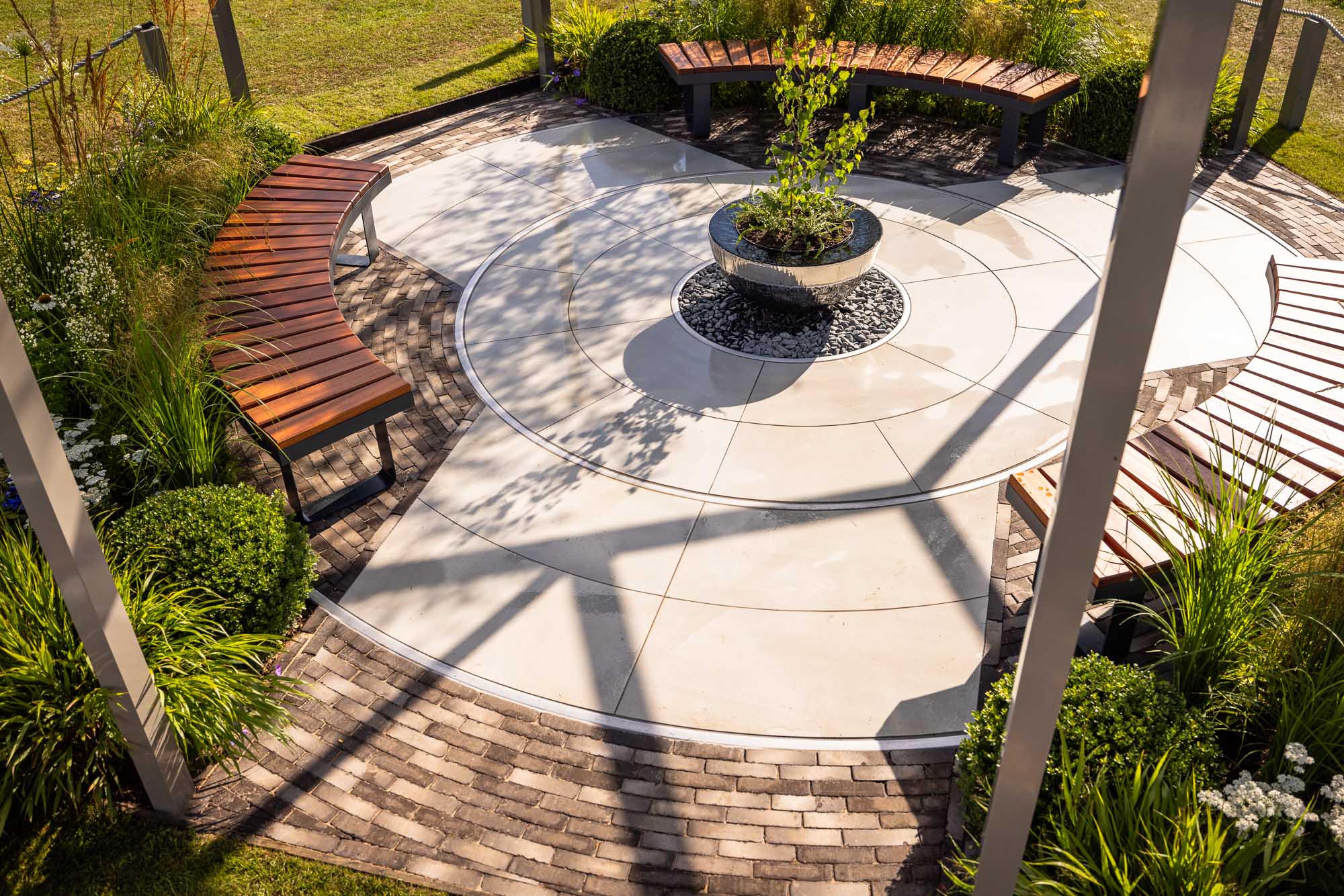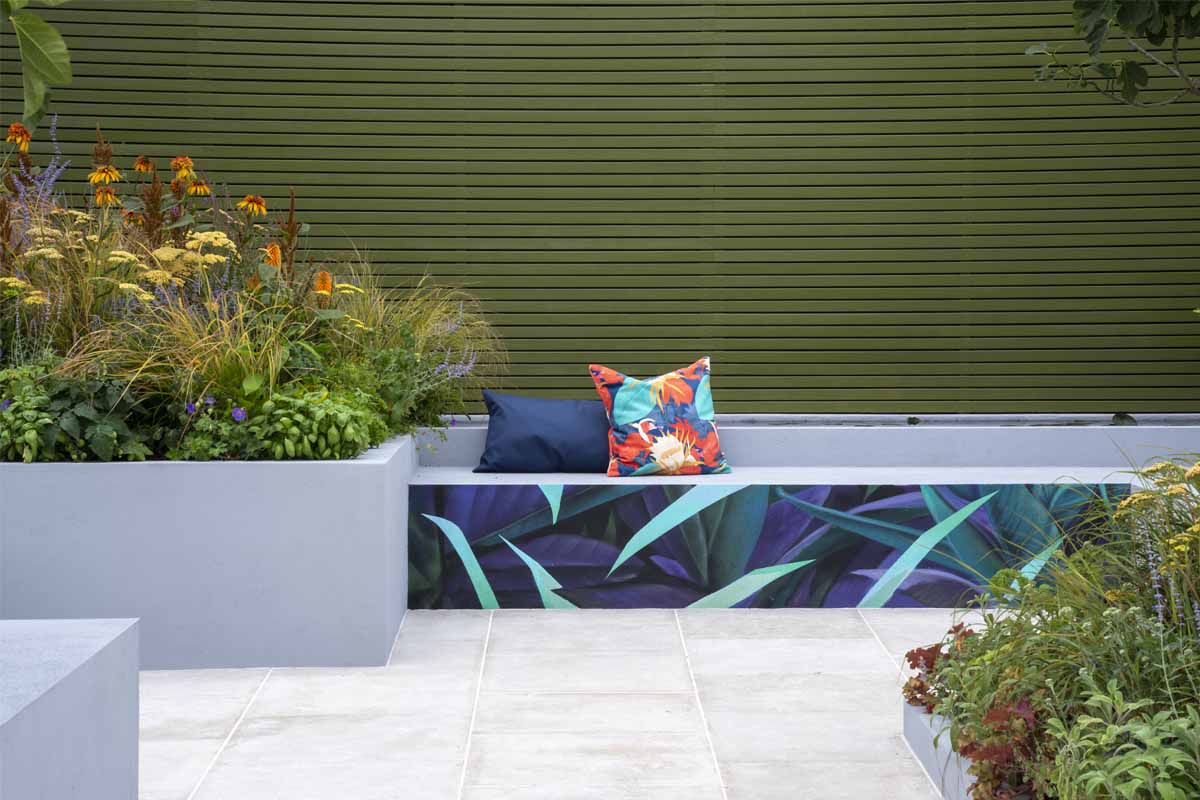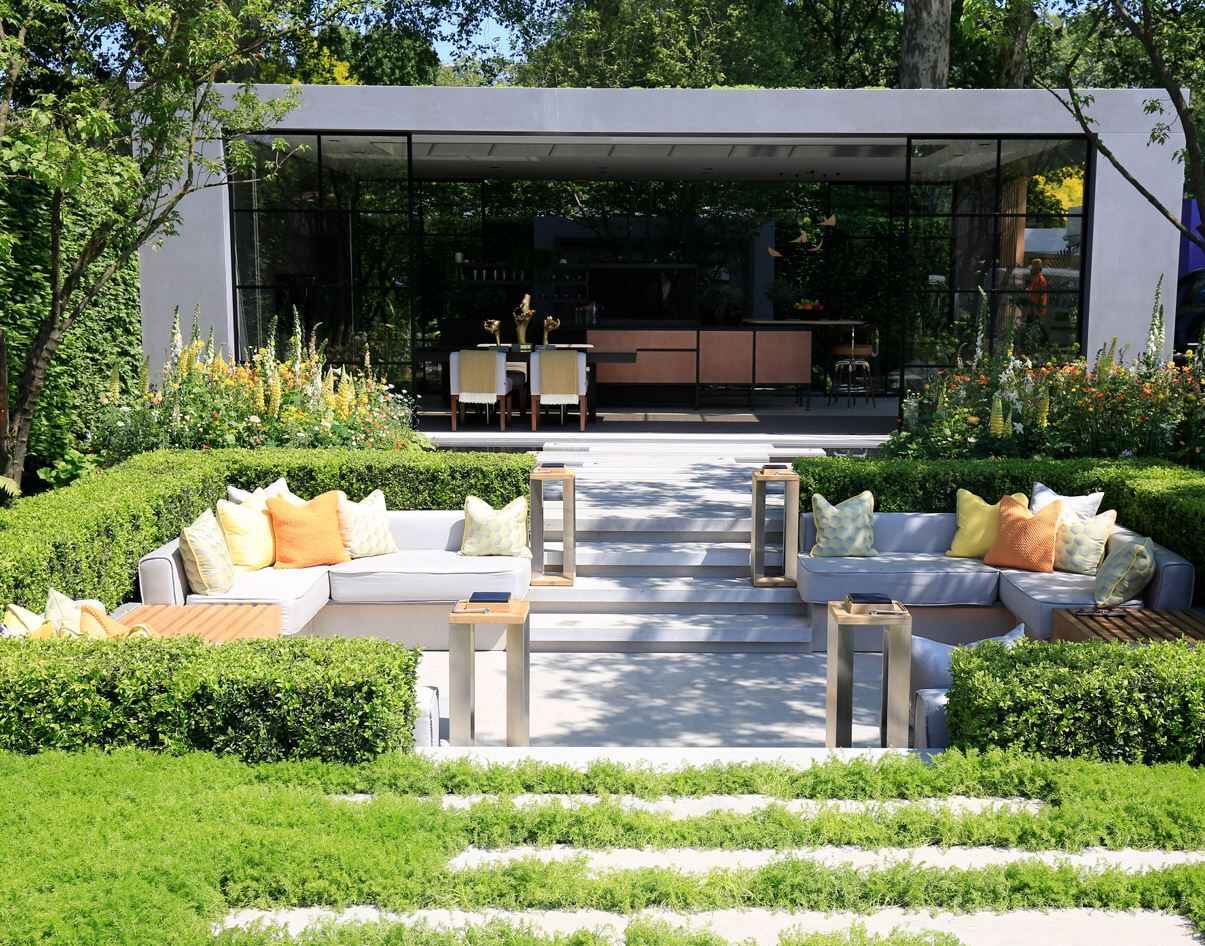Adam Stewart is one of the UK’s top landscapers and a winner of Pro Landscaper’s 30 Under 30 in 2021. Here he explains why he prefers natural stone paving to porcelain.
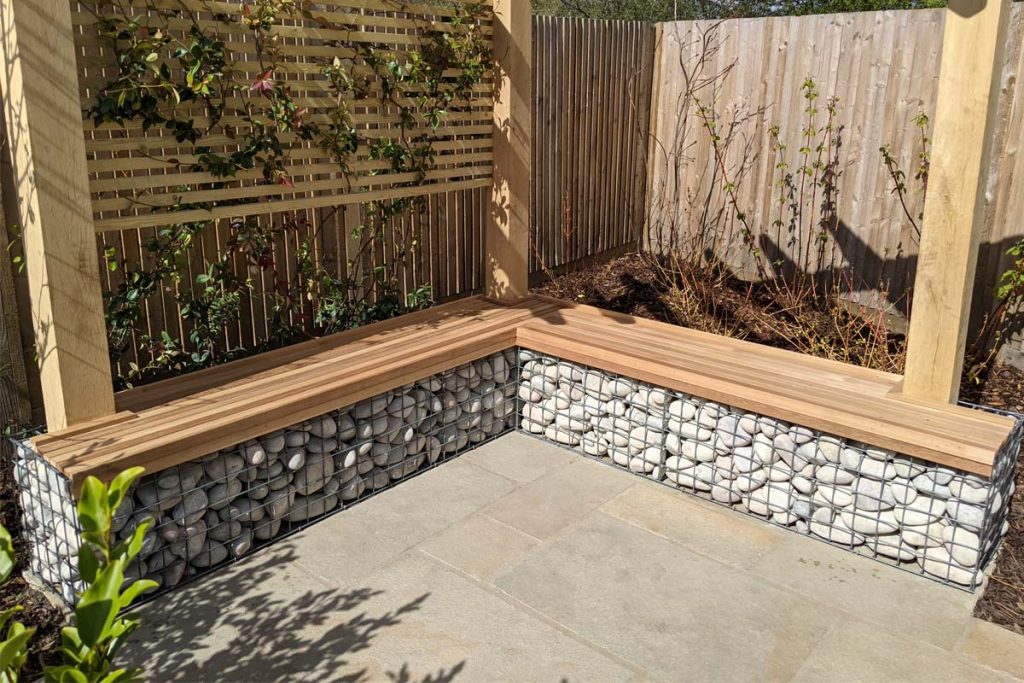
“It’s a topic I’m particularly passionate about,” says Adam forcefully. “Porcelain pavers v natural stone. In the world of landscaping, both materials have their merits, but natural stone consistently wins my heart.”
But why? After all, outdoor porcelain has many admirers and has taken the landscaping world by storm since its introduction in the last ten years.
Naturally different
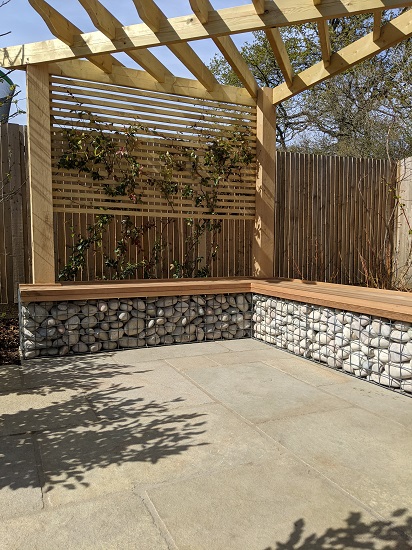
“It’s the uniqueness of each slab,” says Adam. “Porcelain is manufactured to be uniform, but natural stone paving is of the earth, produced over millions of years. Each piece tells its own story, with no two slabs exactly alike.”
This variety is down to the organic markings and colours laid down as the rock was formed, with different minerals adding character—something that is particularly apparent in the wide choice of sandstone colours.
“These variations are signatures of Nature,” says Adam. “They add character and depth. The colour palette available in natural stone is unparalleled and natural variations can turn a simple patio into a stunning focal point.”
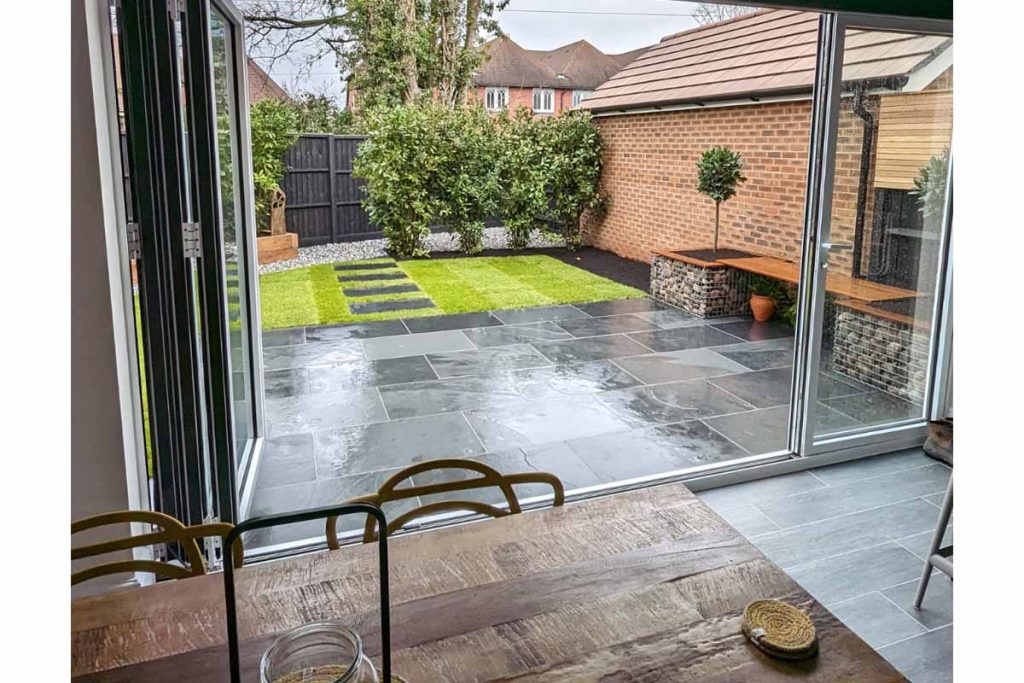
Of course, it’s the consistency that many people like about porcelain paving—the fact that you know exactly what you’re getting. Many colours, especially stone-effect porcelain, offer a generous number of differently patterned slabs to create a more natural effect. But this doesn’t cut any ice with Adam. “Porcelain is manufactured to look like stone, but it can never truly capture the essence of natural materials. The variety in natural stone adds a special touch,” he adds. “ensuring that your garden is truly one of a kind.”
Natural texture
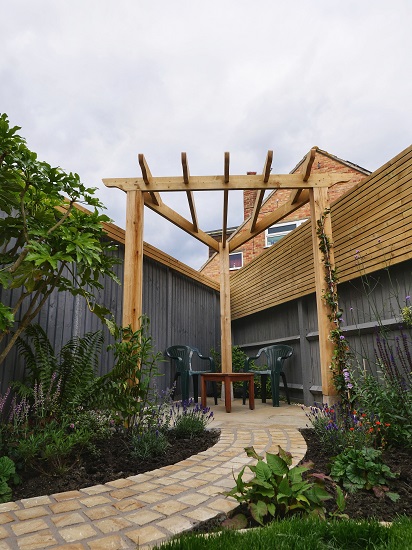
Texture is every bit as important when it comes to choosing materials, especially if you like to walk barefoot. “Natural stone has a tangible quality that porcelain simply can’t replicate,” says Adam, warming to his subject. It’s hard not to feel equally enthused as he adds lovingly, “The feel underfoot, the slight irregularities in the surface, the way it ages gracefully over time—all this contributes to stone’s ‘personality’.”
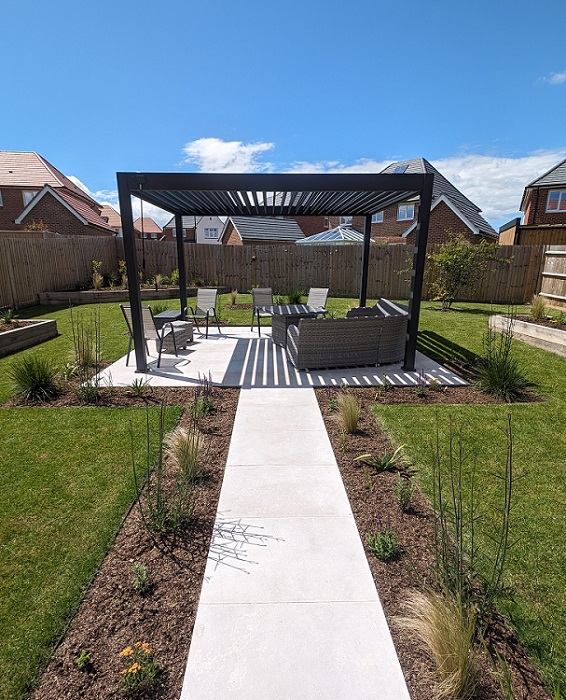
Adam's favourite natural stone
Does he have a favourite? “Egyptian limestone is one of them. It has a smooth, almost velvety texture that’s a pleasure to walk on.”
This is an aspect that many people might not think of in relation to paving, appealing to the sense of touch as well as vision. Limestones like Egyptian Beige or Jura Beige and Jura Grey often feature small fossils or something more striking. “Some slabs even feature beautiful ammonites,” he points out. “They offer a glimpse into ancient history right in your back garden.”
Take a look at elegant patio designs in Egyptian and Jura Grey limestone.
Making history
It's this connection to history that clinches it for Adam. “Stones like Egyptian limestone have been used in construction for thousands of years. The knowledge that your garden patio shares a material lineage with ancient structures adds a profound sense of continuity.”
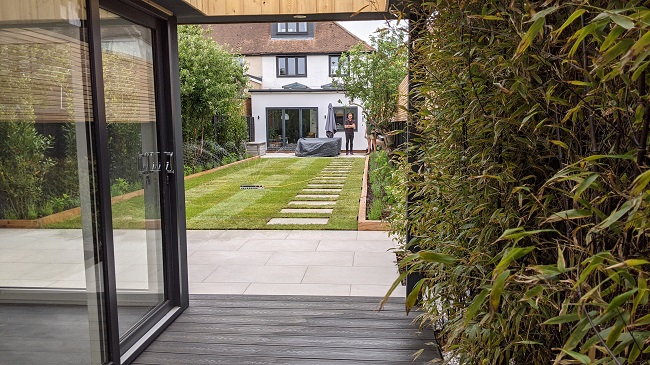
Of course, porcelain in various forms is old too (think Chinese Tang dynasty), but it’s difficult to compete with prehistory. “Natural stone offers a raw beauty that evolves over time, developing a patina that enhances its appearance as the years go by.”
Adam is happy to work with porcelain, as you can see in the above picture. Many landscapers prefer it for its uniform manufacture. With every slab exactly the same depth—there’s no tolerance to dimensions as there is with natural stone—some find it quicker to lay. Narrower joints are also possible, which increases the contemporary feel.
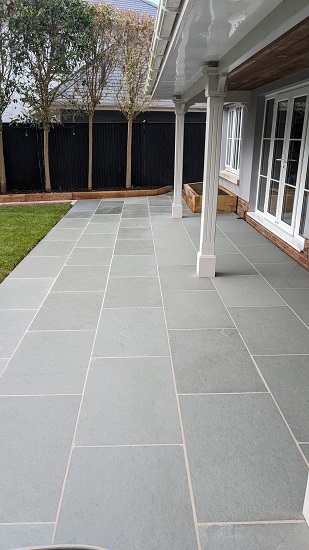
Adam relishes the differences, though, that are inherent in a natural product. “Natural stone helps us achieve our vision at Utopia Landscapes, of creating outdoor spaces that reflect the uniqueness and personality of their owners.”
Explore the rich choice in natural stone
Well, there you have it. Next time you’re pondering the choice of porcelain pavers v natural stone, think about the variety of stone paving. There’s a style for everyone, whether you prefer patio designs in cool Graphite Grey, the rich tones of granite, or the rugged charm of slate.
Be inspired by natural stone patio ideas and discover how, as Adam says, “Natural stone provides a rich tapestry of textures, colours and patterns that bring a garden to life.”
With thanks to Utopia Landscapes for their help with this article.


/filters:quality(60)/mediadev/media/menu-pics/all-porcelain.jpg )
/filters:quality(60)/mediadev/media/menu-pics/luxury-italian.jpg )
/filters:quality(60)/mediadev/media/menu-pics/premium-italian.jpg )
/filters:quality(60)/mediadev/media/menu-pics/budget-porcelain.jpg )
/filters:quality(60)/mediadev/media/menu-pics/large-format-porcelain.jpg )
/filters:quality(60)/mediadev/media/menu-pics/wood-effect-porcelain.jpg )
/filters:quality(60)/mediadev/media/menu-pics/porcelain-planks.jpg )
/filters:quality(60)/mediadev/media/menu-pics/porcelain-setts.jpg )
/filters:quality(60)/mediadev/media/menu-pics/browse-all-paving.jpg )
/filters:quality(60)/mediadev/media/menu-pics/stone-paving.jpg )
/filters:quality(60)/mediadev/media/menu-pics/interior-tiles.jpg )
/filters:quality(60)/mediadev/media/menu-pics/stone-effect-porcelain.png )
/filters:quality(60)/mediadev/media/menu-pics/wood-effect-porcelain.png )
/filters:quality(60)/mediadev/media/menu-pics/grey-porcelain.png )
/filters:quality(60)/mediadev/media/menu-pics/beige-porcelain.png )
/filters:quality(60)/mediadev/media/menu-pics/dark-porcelain.png )
/filters:quality(60)/mediadev/media/menu-pics/light-porcelain.png )
/filters:quality(60)/mediadev/media/menu-pics/patio-grout.jpg)
/filters:quality(60)/mediadev/media/menu-pics/primers.jpg)
/filters:quality(60)/mediadev/media/menu-pics/porcelain-blades.jpg)
/filters:quality(90)/mediadev/media/menu-pics/drainage.jpg)
/filters:quality(60)/mediadev/media/menu-pics/cleaners.jpg)
/filters:quality(60)/mediadev/media/menu-pics/all-stone-paving.jpg )
/filters:quality(60)/mediadev/media/menu-pics/all-sawn-paving.jpg )
/filters:quality(60)/mediadev/media/menu-pics/all-riven-paving.jpg )
/filters:quality(60)/mediadev/media/menu-pics/indian-sandstone.jpg )
/filters:quality(60)/mediadev/media/menu-pics/limestone-paving.jpg )
/filters:quality(60)/mediadev/media/menu-pics/granite-paving.jpg )
/filters:quality(60)/mediadev/media/menu-pics/slate-paving.jpg )
/filters:quality(60)/mediadev/media/menu-pics/yorkstone-paving.jpg )
/filters:quality(60)/mediadev/media/menu-pics/stone-pavers.jpg )
/filters:quality(60)/mediadev/media/menu-pics/cobbles-setts.jpg )
/filters:quality(60)/mediadev/media/menu-pics/plank-paving.jpg )
/filters:quality(60)/mediadev/media/menu-pics/paving-circles.jpg )
/filters:quality(60)/mediadev/media/menu-pics/bespoke-paving-1.jpg )
/filters:quality(60)/mediadev/media/menu-pics/edging-stones-1.jpg )
/filters:quality(60)/mediadev/media/menu-pics/prestige-stone.jpg )
/filters:quality(60)/mediadev/media/menu-pics/grey-blue-stone.png)
/filters:quality(60)/mediadev/media/menu-pics/swatch-black-dark.jpg )
/filters:quality(60)/mediadev/media/menu-pics/swatch-buff-beige-white.jpg )
/filters:quality(60)/mediadev/media/menu-pics/sealants.jpg)
/filters:quality(60)/mediadev/media/menu-pics/all-clay-paving.jpg )
/filters:quality(60)/mediadev/media/menu-pics/alpha-clay-pavers.jpg )
/filters:quality(60)/mediadev/media/menu-pics/cottage-garden-clay-pavers.jpg )
/filters:quality(60)/mediadev/media/menu-pics/kessel-garden-clay-pavers.jpg )
/filters:quality(60)/mediadev/media/menu-pics/artisan-clay-pavers.jpg )
/filters:quality(60)/mediadev/media/menu-pics/grey-blue-clay-paver.png )
/filters:quality(60)/mediadev/media/menu-pics/red-brown-clay-pavers.png )
/filters:quality(60)/mediadev/media/menu-pics/beige-buff-clay-pavers.png )
/filters:quality(60)/mediadev/media/menu-pics/composite-decking.jpg )
/filters:quality(60)/mediadev/media/menu-pics/designboard-decking.jpg )
/filters:quality(60)/mediadev/media/menu-pics/classic-designboard.jpg )
/filters:quality(60)/mediadev/media/menu-pics/brushed-designboard.jpg )
/filters:quality(60)/mediadev/media/menu-pics/grooved-designboard.jpg )
/filters:quality(60)/mediadev/media/menu-pics/millboard-decking.jpg )
/filters:quality(60)/mediadev/media/menu-pics/grey-decking.jpg )
/filters:quality(60)/mediadev/media/menu-pics/black-charcoal-decking.jpg)
/filters:quality(60)/mediadev/media/menu-pics/brown-decking.jpg)
/filters:quality(60)/mediadev/media/menu-pics/all-build-deck.png )
/filters:quality(60)/mediadev/media/menu-pics/stone-cladding.jpg )
/filters:quality(60)/mediadev/media/menu-pics/all-garden-walling-1.jpg )
/filters:quality(60)/mediadev/media/menu-pics/facing-bricks.jpg )
/filters:quality(60)/mediadev/media/menu-pics/garden-screening.jpg )
/filters:quality(60)/mediadev/media/menu-pics/all-steps-coping.jpg )
/filters:quality(60)/mediadev/media/menu-pics/stone-garden-steps.jpg )
/filters:quality(60)/mediadev/media/menu-pics/sawn-steps.jpg )
/filters:quality(60)/mediadev/media/menu-pics/riven-steps.jpg )
/filters:quality(60)/mediadev/media/menu-pics/yorkstone-steps.jpg )
/filters:quality(60)/mediadev/media/menu-pics/bespoke-steps.jpg )
/filters:quality(60)/mediadev/media/menu-pics/porcelain-steps.jpg )
/filters:quality(60)/mediadev/media/menu-pics/off-the-shelf.jpg )
/filters:quality(60)/mediadev/media/menu-pics/stone-coping.jpg )
/filters:quality(60)/mediadev/media/menu-pics/sawn-coping.jpg )
/filters:quality(60)/mediadev/media/menu-pics/riven-coping.jpg )
/filters:quality(60)/mediadev/media/menu-pics/yorkstone-coping.jpg )
/filters:quality(60)/mediadev/media/menu-pics/bespoke-coping.jpg )
/filters:quality(60)/mediadev/media/menu-pics/stone-pier-caps.jpg )
/filters:quality(60)/mediadev/media/menu-pics/porcelain-coping.jpg )
/filters:quality(60)/mediadev/media/menu-pics/all-bespoke-services.jpg )
/filters:quality(60)/mediadev/media/menu-pics/bespoke-paving-2.jpg )
/filters:quality(60)/mediadev/media/menu-pics/bespoke-steps-1.jpg )
/filters:quality(60)/mediadev/media/menu-pics/bespoke-coping-1.jpg )
/filters:quality(60)/mediadev/media/menu-pics/edge-profiles.jpg )
/filters:quality(60)/mediadev/media/menu-pics/masonry-services.jpg )
/filters:quality(60)/mediadev/media/menu-pics/deluxe-pergolas.jpg )
/filters:quality(60)/mediadev/media/menu-pics/proteus-pergolas.jpg )


